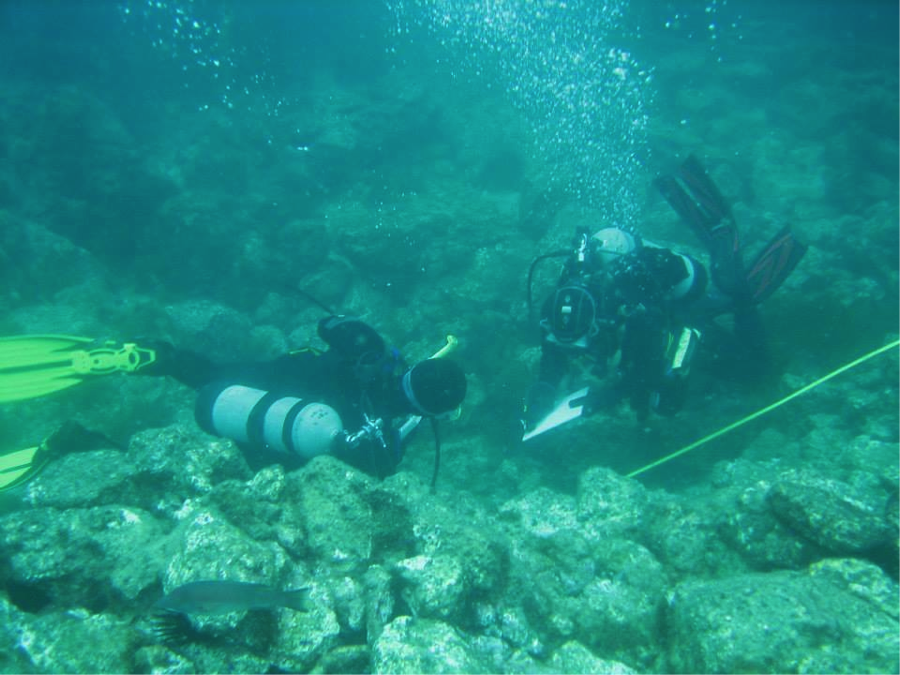By: Elise Steinberger
As the days on Catalina grow shorter, research projects at the marine lab are drawing to a close. Little known to many people, the USC Wrigley Marine Science Center hosts many semester-long classes at the island campus – these programs include both USC classes and courses led by other universities.
One class visiting Catalina this fall is the UCLA Marine Biology Quarter, a field program for advanced undergraduates. Students from UCLA have been working on research since they arrived on the island 5 weeks ago. The students designed projects during an intensive 2.5 weeks at UCLA’s campus before arriving, so they showed up with research questions and hit the ground running. From day one, they busily drove, walked, swam, and kayaked around the island for their projects. The projects ranged from searching for brittle sea stars to manipulating water temperatures of hermit crabs, and involved both observing animals in the field and manipulating experimental conditions in labs.
Jordan Beasley and Kirsten Denicola, two seniors at UCLA, spent their days studying brittle sea stars – both in the lab and in the field. They sought to better understand what factors, particularly colors of light, influence ecological preferences of sea stars. To do this, Jordan and Kirsten surveyed rocky intertidal zones of Isthmus and Cherry Coves and conducted various lab trials. Though they will finish their data analysis when they return to the mainland, research of this type could be useful when studying climate change – as the habitat choices of brittle sea stars might indicate the quality of the water and the relative amounts of different colors of light that come through. Kirsten says the Marine Biology Quarter has helped her understand more of what research is all about, as she decides what to pursue after graduation. For both students this was the first time they were able to independently lead research projects of this scale.
Another student project with implications for climate change is that of Kelly Wong and Colin Shew. Their research explored the effects of water temperature on the reflexes of sea hares. Kelly and Colin both enjoyed designing their own experiments for the first time, as they are both considering graduate school in the coming years. They joked about this experience as a “graduate school boot camp.” As with all the students, they were responsible for setting their own project schedules and felt that the wealth of resources available to them at the marine lab was crucial.
Satthea Khay, a senior studying biology and looking towards a career in medicine, and sought out living and working on Catalina Island as her way of “stepping outside my comfort zone a little bit – giving something else a shot.” Satthea likens the Marine Biology Quarter to studying abroad and made the most of her time in the field in order to see a different side of research. Previously, she had worked in microbiology and cell biology research labs; she felt the field aspect of the Catalina program is unique, saying it showed her that “research doesn’t just have to be in the lab.” She is considering combine her interests in ecology and health by doing epidemiological work.
The opportunity to research in the field was a common draw for the UCLA students. Lexey Dalmau, also a senior studying biology, describes herself as an outdoorsy person and knew that researching on the island would offer plenty of hours in the Catalina sunshine. Like many groups, she and Kimberly Mak spent time in various coves and harbors around the island while exploring hermit crab shell preferences. After working as a lab assistant at UCLA, Lexey was excited at the prospect of running her own experiments. She says, “We’ve taken a lot of classes about ecology and behavior; but, being out here and seeing it first hand makes you understand it even more.”
When the students return to UCLA’s campus, they will have another 2.5 weeks to complete their data analyses and put pen to paper as they summarize and present their findings. For all the students, it has been an intense 5 weeks of around-the-clock research and data collection. For many, the experience has also helped clarify their next steps after graduation and whether they see graduate school on the horizon. Wherever their paths may lead, they will always take with them the skills they developed as independent researchers – and hopefully many happy memories of their sunny days wading in intertidal zones around Catalina Island.
Elise Steinberger is a fall intern at the Wrigley Marine Science Center, here to learn more about marine science before beginning her Master’s in Health and Science Writing at Northwestern University.


